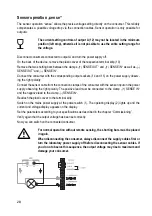
23
Functional Description
The laboratory power supply works with highly developed combinational circuit technology and active
PFC (power factor correction). This ensures a stable output voltage and a high degree of effectiveness.
The DC outputs are electrically isolated and feature a protective isolation towards the mains voltage. The
secondary DC connection is effected via two coloured safety sockets.
The clear displays show the voltage and current for output A (V = Volt = unit of electric voltage, A =
Ampere = unit of electric current).
Output B is displayed via a button on the display of output A.
Via light displays the current condition of the power supply is indicated. Various protective mechanisms,
e.g. overload protection, current limitation, overheating protection, etc. are built in for secure and reliable
operation.
The cooling of the power supply is provided via integrated ventilators. Therefore, ensure sufficient air cir-
culation.
The power supply can set the output voltage and the output current continuously (with output B the volt-
age only).
Start-up
The laboratory power supply is not a charger. To charge batteries, use suitable
chargers with a charging current cut-off.
During a longer period of operation under nominal load, the surface of the hous-
ing will heat up. Attention! Risk of burns! Therefore, make sure that there is ade-
quate ventilation of the power unit and never operate it partly or fully covered to
avoid any damage.
When connecting a consumer ensure that it is not connected when switched on.
A switched on consumer can result in sparks when connecting to the output ter-
minals of the power supply, which in turn can damage the sockets or the con-
nected cables and/or their clamps.
If your power supply is not required, disconnect it from the mains.
Connecting the power cable
Connect the supplied earthing mains cable to the low-power device installation socket (18) on the power
supply. Ensure a tight fit.
Connect the power cable to a shockproof mains socket with protective grounding.
















































